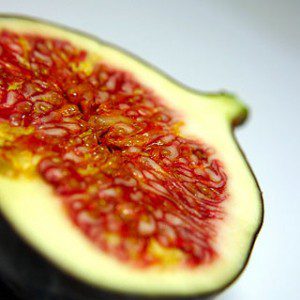By Stephanie Rogers – ecosalon.com
You might think that slice of bread on your plate is necessary to get the fiber you need to be healthy. Think again. Bread isn’t all it’s cracked up to be, and there are plenty of foods that can give you all the fiber you need on a daily basis. These 10 fiber-filled all-stars including avocados, cinnamon, raspberries and eggplant have far more fiber and nutrition per calorie than wheat, and lots of other health benefits, too. Combine as many as you can in one dish, like black beans with oregano, mustard greens, avocados and barley, for one of the healthiest meals of your life.
Figs
Figs are a deliciously high-fiber fruit, containing 6.58 grams in an eight-ounce serving. You can get dried figs year-round but there’s nothing quite like a juicy, fresh fig. These fruits are a great source of calcium and are also high in potassium and manganese. According to a 2008 study, there’s another compelling reason to consume figs as often as possible: fiber from fruits may help prevent post-menopausal breast cancer.
[pro_ad_display_adzone id=”110028″]
Avocados
Rich and creamy, avocados can seem like a splurge. While they are dense in fat and calories, spreading a little bit on your tortilla or chopping it up for salad not only adds a lot of flavor to your meal, it also boosts your fiber intake. At 14 grams apiece, avocados contain more fiber per ounce than any other fruit. Of a single avocado’s 24 grams of fat, only 4 are saturated, so they help lower “bad” LDL cholesterol and raise “good” HDL levels. They’re also rich in lycopene, beta carotene, lutein, magnesium and the vitamins B, E and K.
Beans
Beans pack the biggest fiber punch of any food, with navy beans topping the charts at over 76% of your daily value per one-cup serving. Dried peas, lentils, pinto beans, black beans and lima beans are also fiber all-stars, providing over half of your daily value. Most types of beans are high in protein, folate, iron and B-vitamins, and very low in fat. Legume consumption has been associated with increased heart health.
Barley
This grain doesn’t get a lot of love. Always in the shadow of its more famous counterparts wheat, oats and rye, barley is used more often as animal fodder or to make beer than it is in our daily diets. But barley is appealingly chewy and sweet, and when it comes to fiber, it’s right up there with beans. A cup will provide over 54% of your daily fiber requirements. The fiber in barley is insoluble, so it provides bulk as it passes through your body, improving the health of your intestines and lowering cholesterol. It’s a great source of selenium, which lowers risk of colon cancer and helps metabolize thyroid hormones.
Eggplant
This deep purple-skinned vegetable is often cooked down to such a mushy state, it’s hard to believe there’s much fiber in it. But in fact, eggplant has nearly three grams of fiber for every 19.7 calories. This means that unlike bread, which is high in calories for just a few grams of fiber, eggplant is an ultra-efficient means of reaching your daily requirements. Nutritionally dense, eggplant will provide you with lots of manganese, potassium, folate, B6, K and C per serving.
Raspberries
So plump and juicy, ripe raspberries are hard to resist – and you shouldn’t even try. With just 63 calories, a cup of raspberries will give you over half your vitamin C and manganese, and a third of your fiber. Their low calories and nutrient density make them another high-value fiber-filled food, and all those phytonutrients with antioxidant, antimicrobial and anti-carcinogenic properties just make them taste even sweeter.
Greens
Mama says eat your greens, and you should heed her wisdom. A cup of mustard greens is one of the healthiest additions to your dinner plate, with 11.2% of your daily value of fiber, 524% of your vitamin K, 177% of vitamin A and 59% of vitamin C and just 21 calories. Collard greens have even more fiber at 5.32 grams per 49.4-calorie serving, Swiss chard boasts 3.67 grams, spinach has 4.32 and kale has 2.6. Even romaine lettuce has nearly 2 grams of fiber in a 16-calorie, 2-cup serving.
Cinnamon
Who would have thought that a spice could contain so much fiber? Sprinkling a teaspoon of cinnamon on your cereal, oatmeal or fruit will provide 5% of your daily fiber needs. Cinnamon also has anti-microbial properties and can help lessen a food’s impact on your blood sugar levels by slowing the rate at which the stomach empties, which is why adding it to a sweet treat is always a good idea. It’s also got lots of calcium and manganese, and research has found that it boosts brain function. Ground cloves come close to cinnamon in fiber content with nearly 3% of your daily value in a teaspoon.
Pears
Seasonal variations in different varieties of pears make them available year-round, and though they seem to be cousins of the apple, pears are actually in the rose family. There are 5.2 grams of fiber in a single, roughly 100-calorie pear. Try baking them into a pie with raspberries and cinnamon, or pair them in a salad with mustard greens and walnuts.
Herbs
Load up on the parsley, sage, rosemary and thyme, not to mention oregano, dill, coriander and fennel. Herbs are an easy way to add extra fiber to any savory meal, and oregano should be your top choice as it’s got 1.53 grams in two teaspoons. Thyme and rosemary each pack over a gram, while coriander seeds have 2.12.
Article Source – ecosalon.com
About the Author
Stephanie Rogers currently resides in North Carolina where she covers a variety of green topics, from sustainability to food.
[pro_ad_display_adzone id=”110027″]
Disclaimer: This article is not intended to provide medical advice, diagnosis or treatment. Views expressed here do not necessarily reflect those of Wake Up World or its staff.







